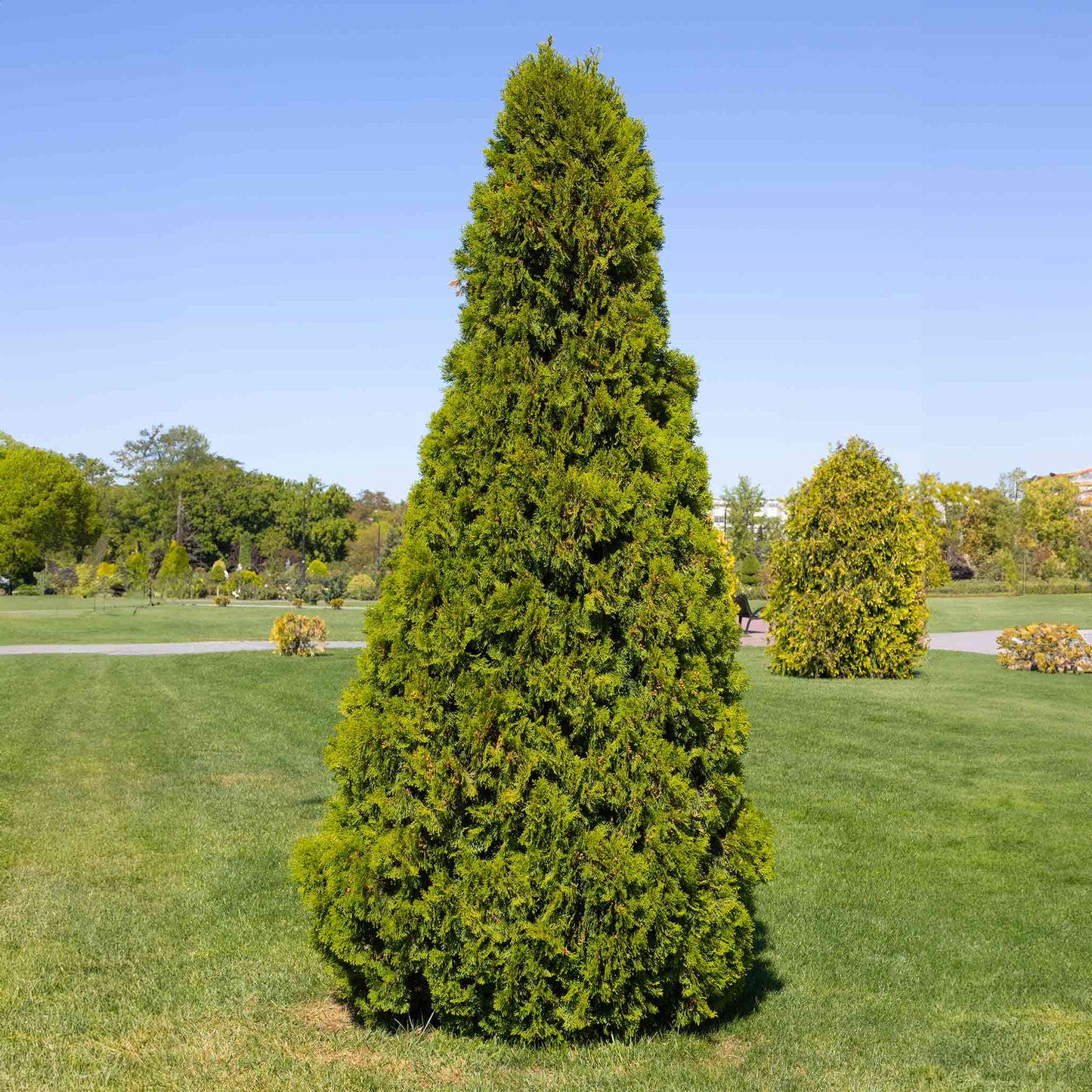Thuja Virginian™
Thuja Virginian™
SKU:EVT-THU-BAB-34-5G
Meet the Thuja Virginian: Your Backyard's New Best Friend!
Looking for a touch of green to make your garden pop? Say hello to the Thuja Virginian, also know as the Baby Giant Thuja! This pint-sized powerhouse might be small now, but don't let its size fool you. It's destined to grow into a magnificent, lush evergreen that will have the neighbors turning green with envy.
Why You'll Love It:
- Easy Peasy: No green thumb? No problem! The Baby Giant Thuja is as low-maintenance as they come. Just plant, water, and watch it thrive.
- Privacy Please: Dreaming of a natural fence? These little giants grow up to provide a dense, living wall that's perfect for some extra privacy.
- Year-Round Beauty: With its vibrant green foliage, the Baby Giant Thuja keeps your garden looking alive, even when other plants take a winter nap.
Planting & Care:
Our Baby Giant Thuja is a cinch to plant. Choose a sunny spot, give it some room to grow, and it'll take care of the rest. A bit of mulch, occasional watering, and you're on your way to a hassle-free, evergreen paradise.
Get Yours Today!
Ready to transform your garden? The Baby Giant Thuja is just a click away. Bring home this garden gem and let the backyard magic begin!


Product Details
-
Product Category
Evergreen Trees
-
Product Subcategory:
Thuja Trees
-
Botanical Name:
Thuja plicata x standishii PPAF 61830744 ‘Virginian™’
-
Does Not Ship To:
AZ, OR
-
Mature Height:
14 ft.
-
Mature Width:
6 ft.
-
Growing Zone:
5-8 outdoors
-
Indoor Growing:
-
Sunlight:
Full Sun
-
Growth Rate:
Moderate
-
Harvest Time:
-
Bloom Time:

Planting Directions
<h2>Planting Thuja Virginian™</h2>
<p>Thuja Virginian™, also known as Eastern Arborvitae, is a popular evergreen shrub. Here's how to plant it:</p>
<ul>
<li>Choose a location with full sun to partial shade and well-draining soil.</li>
<li>Space plants 3 to 4 feet apart to ensure proper air circulation.</li>
<li>Dig a hole as deep as the root ball and twice as wide.</li>
<li>Remove the plant from its container and gently loosen the roots.</li>
<li>Place the plant in the hole, ensuring the top of the root ball is level with the soil surface.</li>
<li>Backfill the hole with soil, tamping down gently to remove air pockets.</li>
<li>Water thoroughly after planting to settle the soil.</li>
<li>Mulch around the base to retain moisture and reduce weeds.</li>
</ul>
<h2>Care and Maintenance</h2>
<p>Follow these steps to ensure your Thuja Virginian™ thrives:</p>
<ul>
<li>Water regularly during the first growing season to establish a deep root system.</li>
<li>Apply a balanced, slow-release fertilizer in early spring.</li>
<li>Prune in late winter or early spring to shape the plant and remove any dead or damaged branches.</li>
<li>Monitor for pests like bagworms and treat with appropriate insecticides if necessary.</li>
</ul>
<p>Thuja Virginian™ does not require pollination for growth and typically does not produce harvestable fruit. It is primarily valued for its foliage and ornamental appeal.</p>
<p>Remember, every plant is unique and may respond differently to care. Observe your Thuja and adjust care as needed for its health and growth.</p>

FAQs
<h2>FAQs for the Thuja Virginian™</h2>
<ol>
<li>
<strong>How do I plant Thuja Virginian™?</strong>
<p>Planting Thuja Virginian™ involves a few key steps to ensure its healthy growth:</p>
<ul>
<li><strong>Choose the right location:</strong> Thuja Virginian™ thrives in full sun to partial shade. Select a spot where the plant will receive at least 6 hours of sunlight daily.</li>
<li><strong>Prepare the soil:</strong> These plants prefer well-drained soil. If your soil is heavy clay or too sandy, amend it with compost to improve its texture and fertility.</li>
<li><strong>Dig the hole:</strong> The hole should be twice as wide and just as deep as the root ball. This gives the roots room to spread out.</li>
<li><strong>Planting:</strong> Remove the plant from its container and gently loosen the roots. Place it in the hole, ensuring it's at the same depth it was in the pot. Backfill the hole, gently tamping down the soil to remove air pockets.</li>
<li><strong>Watering:</strong> Water the plant thoroughly after planting to settle the soil around the roots and help with the initial stress of transplanting.</li>
</ul>
</li>
<li>
<strong>How often should I water my Thuja Virginian™?</strong>
<p>Watering frequency for Thuja Virginian™ depends on several factors, including soil type, weather, and plant size:</p>
<ul>
<li><strong>Initial watering:</strong> Water every other day for the first week after planting to help establish roots.</li>
<li><strong>Established plants:</strong> Once established, they are relatively drought-tolerant but perform best with regular watering. Aim for about 1 inch of water per week, either from rainfall or supplemental watering.</li>
<li><strong>Monitoring:</strong> Check the soil moisture regularly. Water when the top 2-3 inches of soil feel dry to the touch.</li>
</ul>
</li>
<li>
<strong>What is the best fertilizer for Thuja Virginian™?</strong>
<p>Thuja Virginian™ benefits from balanced, slow-release fertilizers that support its growth throughout the season:</p>
<ul>
<li><strong>Type:</strong> Use a balanced fertilizer, such as a 10-10-10 or 20-20-20 formula, applied in early spring and again in mid-summer.</li>
<li><strong>Application:</strong> Follow the manufacturer's instructions for the correct amount. Generally, apply the fertilizer around the base of the plant, avoiding direct contact with the foliage and stem.</li>
<li><strong>Organic options:</strong> Compost or well-rotted manure can also be beneficial, providing nutrients slowly over time.</li>
</ul>
</li>
<li>
<strong>Do I need to prune my Thuja Virginian™?</strong>
<p>Pruning is not strictly necessary for Thuja Virginian™, but it can help maintain shape and encourage denser growth:</p>
<ul>
<li><strong>When to prune:</strong> Late winter or early spring, before new growth begins, is the best time to prune.</li>
<li><strong>How to prune:</strong> Use clean, sharp pruning shears. Trim any dead or damaged branches first, then shape as desired, being careful not to cut into old wood where new growth may not regenerate.</li>
<li><strong>Maintenance pruning:</strong> Lightly trimming the tips of the branches can encourage a fuller appearance.</li>
</ul>
</li>
<li>
<strong>How do I protect my Thuja Virginian™ from pests and diseases?</strong>
<p>Thuja Virginian™ is relatively resistant to pests and diseases, but there are a few steps you can take to keep it healthy:</p>
<ul>
<li><strong>Monitoring:</strong> Regularly check your plant for signs of stress, such as discolored leaves or unusual growths.</li>
<li><strong>Good hygiene:</strong> Keep the area around your Thuja free of debris and fallen leaves to reduce the risk of disease.</li>
<li><strong>Proper watering:</strong> Avoid overhead watering to reduce the risk of fungal diseases. Water at the base of the plant early in the day.</li>
<li><strong>Pest control:</strong> If you notice pests, such as spider mites or scale, consult with a local garden center for appropriate treatment options.</li>
</ul>
</li>
</ol>



